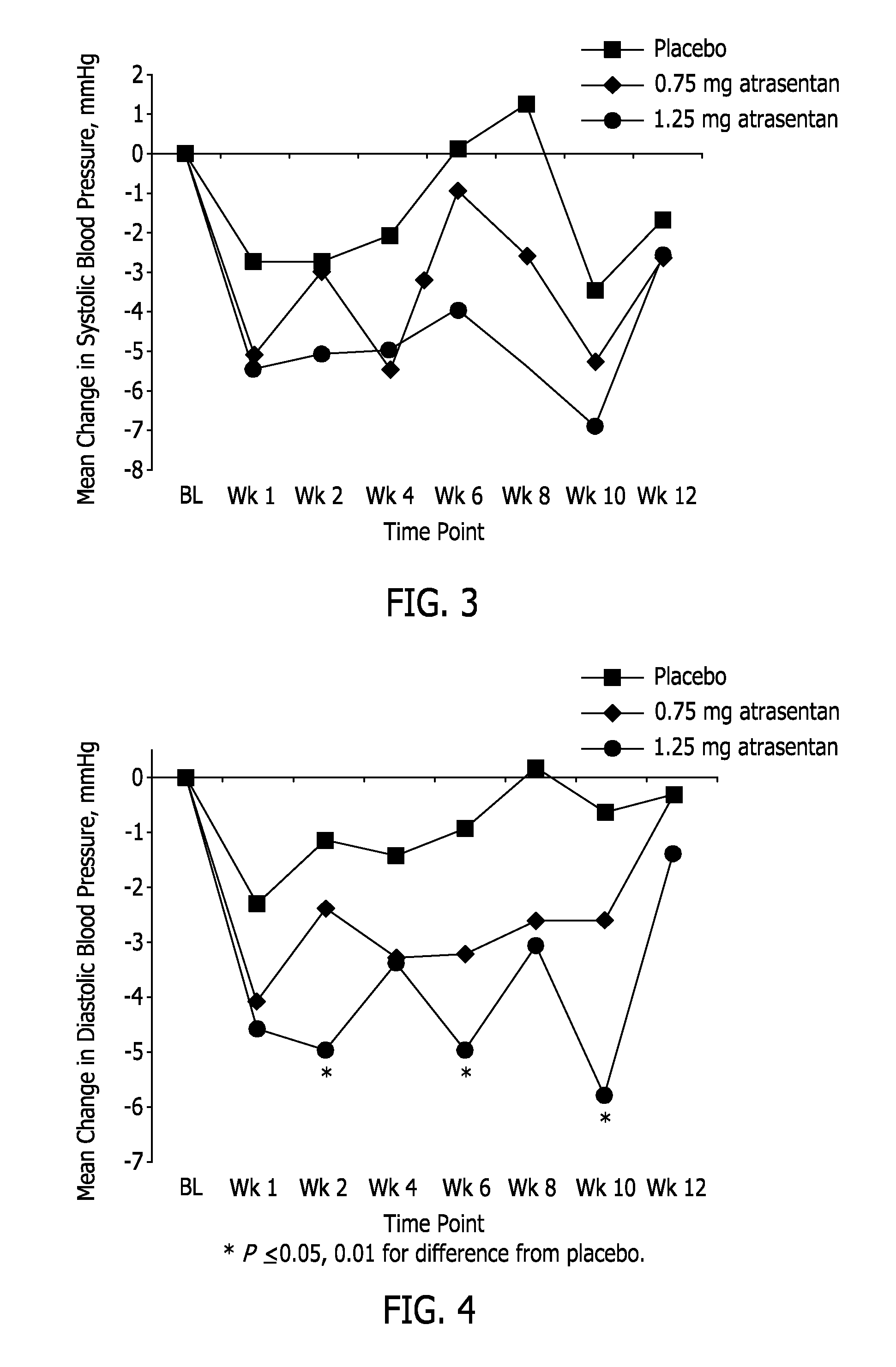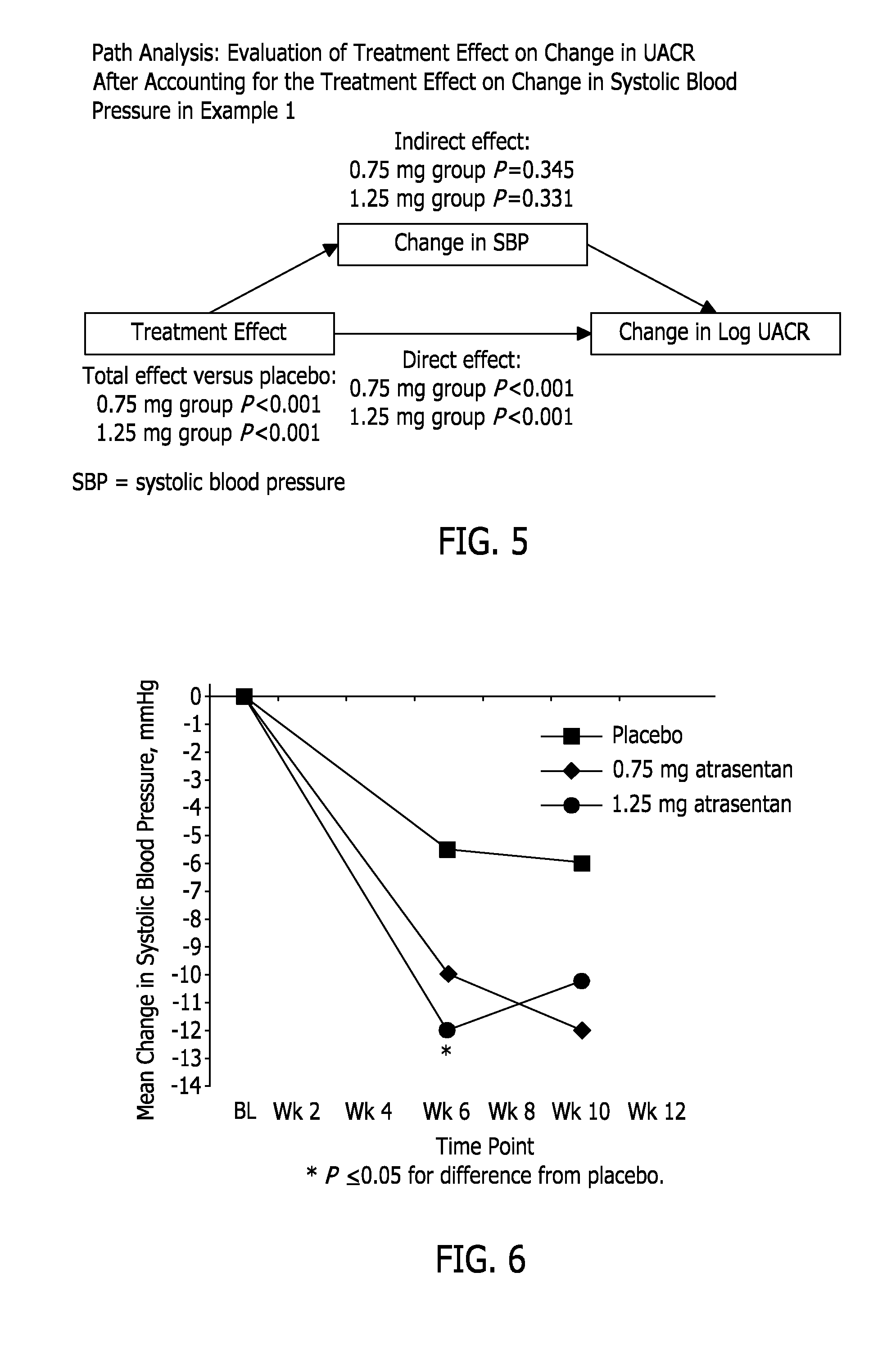Methods for improving lipid profiles using atrasentan
a technology of atrasentan and lipid profiles, applied in the field of atrasentan, can solve the problems of no clinically significant or therapeutically beneficial effects reported, and achieve the effect of reducing cardiovascular risk
- Summary
- Abstract
- Description
- Claims
- Application Information
AI Technical Summary
Benefits of technology
Problems solved by technology
Method used
Image
Examples
example 1
[0134]This example reports a Phase 2b clinical study, in which two doses of atrasentan were evaluated: 0.75 mg and 1.25 mg (both QD). It was a randomized, double-blind, parallel-design, placebo-controlled, 12-week, multicenter study to select an effective atrasentan dose for lowering UACR with minimal effect on fluid retention and lowering blood pressure in subjects with type 2 diabetes and nephropathy who are receiving maximum tolerated labeled doses of a RAS inhibitor and a diuretic, unless medically contraindicated. There were 153 subjects randomized (1:2:2) into 3 treatment groups: 1) placebo, 2) atrasentan 0.75 mg / day, and 3) atrasentan 1.25 mg / day.
[0135]Demographic information for the subjects is set forth in Table 1. There were no statistically significant differences between treatment groups in demographics or baseline characteristics. The requirement that the subjects be taking a maximum tolerated labeled dose of a RAS inhibitor is reflected in the range of blood pressure a...
example 2
[0158]This example describes a Phase 2b, randomized, double-blind, parallel-design, placebo-controlled, 12-week, multicenter study conducted in Japan to select an effective atrasentan dose for lowering UACR with minimal effect on fluid retention and lowering blood pressure in subjects with type 2 diabetes and nephropathy who are receiving maximum tolerated labeled doses of a RAS inhibitor and a diuretic, unless medically contraindicated. Fifty-eight subjects were randomized (1:1:1) into 3 treatment groups: 1) placebo, 2) atrasentan, 0.75 mg / day, and 2) atrasentan, 1.25 mg / day.
[0159]All subjects were Asian. Demographics and baseline characteristics are set forth in Table 7. There were no statistically significant differences between treatment groups in demographics or baseline characteristics, except for the distribution of males and females among treatment groups (P=0.035). The requirement that the subjects be taking a maximum tolerated labeled dose of a RAS inhibitor is reflected i...
example 3
[0181]This example describes a Phase 2b, randomized, double-blind, parallel-design, placebo-controlled, multicenter study to select an effective atrasentan dose for lowering UACR with minimal effect on fluid retention and lowering blood pressure in subjects with type 2 diabetes and nephropathy who are receiving maximum tolerated labeled doses of a RAS inhibitor and a diuretic, unless medically contraindicated. Unlike the previous Phase 2b studies, this example had a shorter treatment period (8 weeks) and evaluated a lower dose of atrasentan (0.5 mg). Forty-eight subjects were randomized (1:1:1) into 3 treatment groups: 1) placebo, 2) atrasentan 0.5 mg / day, and 2) atrasentan 1.25 mg / day. This study also included measurement of thoracic bioimpedance to assess the potential for thoracic fluid retention with atrasentan.
[0182]A total of 48 subjects were enrolled into this study, with 16 subjects each in the placebo, atrasentan 0.5 mg, and atrasentan 1.25 mg treatment groups. Demographics...
PUM
| Property | Measurement | Unit |
|---|---|---|
| Fraction | aaaaa | aaaaa |
| Fraction | aaaaa | aaaaa |
| Fraction | aaaaa | aaaaa |
Abstract
Description
Claims
Application Information
 Login to View More
Login to View More - R&D
- Intellectual Property
- Life Sciences
- Materials
- Tech Scout
- Unparalleled Data Quality
- Higher Quality Content
- 60% Fewer Hallucinations
Browse by: Latest US Patents, China's latest patents, Technical Efficacy Thesaurus, Application Domain, Technology Topic, Popular Technical Reports.
© 2025 PatSnap. All rights reserved.Legal|Privacy policy|Modern Slavery Act Transparency Statement|Sitemap|About US| Contact US: help@patsnap.com



